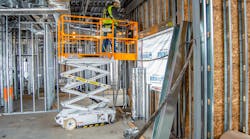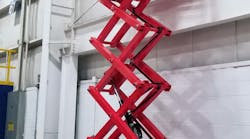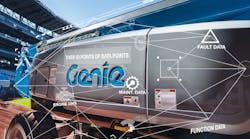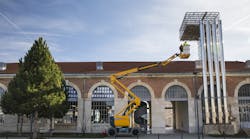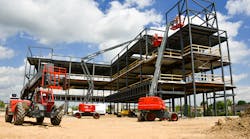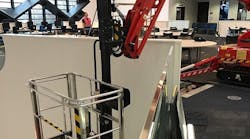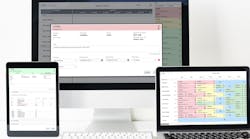Interviews with Generator Manufacturers: Telematics and Load Management
The Participants:
Eric Massinon, business development manager at Chicago Pneumatic Power Technique
Brian Northway, field service manager, Allmand Bros.
Gregg Eberhardt, product manager, Generac Mobile Products.
Todd Howe, product manager - generators and light towers, Doosan Portable Power
Jeff Durgin, global product manager, Makinex
Angel Nieto, product manager power & light, Atlas Copco Power Technique
Anne Feudner, product manager – mobile generators, Kohler Power
Melinda Doty, North American channel development manager, Caterpillar
RER: What is new technologically for your company in generators?
Howe: We are working on two fronts. One is the continued emergence of telematics systems and the integration of telematics systems. Telematics systems have been around for a good long while, but there has been much more customer adoption recently, so we’ve been hard at work making the ability to integrate systems into our units. We’re also working on our own strategy internally in terms of having an offering to provide the customers that need it, but I’d say the short-term focus has been to make sure our units are capable of working with the variety of third-party telematics systems that are out there in the marketplace.
The other area we’ve been working hard at is load-management technology, as the world has made the transition to Tier 4. There have been some application challenges to Tier 4, especially light load and cyclical applications, which are very common real world uses for mobile gensets and rental gensets particularly.
So we’ve been working on ways to provide a good mitigation for light load operation that’s built into the machine. That way we don’t have to deal with external solutions like load banks, and you don’t need to be dealing with the constant service calls and downtimes that might be associated with machine operations when you’re running light loads. We’ve developed our intelligent load-management systems. It started making its way into the larger end of our product line a couple of years ago, and it’s been very successful, so we’ve been adapting that technology into other parts of our product range. It’s coming out soon in our mid-range products – G70, 125 and 150 -- and ultimately we’ll be offering a solution that covers the entire product range as we continue to work forward in our development.
We see load management as being a necessary requirement for our customer base because we are so focused on the rental market and rental type applications and we feel load management is an essential part of the mix these days to provide the ultimate in reliability and uptime for customers and take the concern away from a rental owner or operator that they have to do a tremendously detailed job of sizing the machine or risk the potential of the machine having downtime because of light load conditions.
Massinon: In the engineering department, one thing CP has done with the newer Tier 4 Final generators is standardize the engines with Diesel Oxidation Catalyst (DOC) or DOC+SCR only. The engineering department avoided diesel particulate filters and regeneration cycles. Across the board from our 25 to 330 kVA generators, we are all DOC. 70 and up is DOC+SCR.
DPF systems inherently are going to clog up and have to be replaced, which is expensive. More functions will go wrong with having the regeneration cycles vs. having a DOC.
CP changed to a Deep Sea controller and also Siemens circuit breakers. These components are readably available or they can be sourced locally.
By virtue of the Tier 4 Final engines, they are all electronic engines. Moving to electronic engines, the equipment now has to have PLC (Programmable Logic Controllers) so each piece of equipment has a computer onboard. Because they are PLC and the fact we are reading more information – that information can be paired through telemetric systems. This allows the operator to get information online or call up their units to see the operating parameters; i.e. if it is loaded properly, fuel level, hour meter, operating temperatures and oil pressures on the engine. This gives them visibility to the products they have out in the field and they can get location.
This technology can be plugged into our new control systems from the electronic engines. The old generators, the mechanical engines the operator would have to put all kinds of pressure transducers and temperature transducers on the older style machines and wire them up. The electronic engines are “plug-and-play” – they can plug in a telemetric system and see it online.
Eberhardt: Our products at Generac Mobile Products continue to evolve to meet customer needs and regulatory requirements. On the regulatory side, emissions is an area that we have to always be aware of and adapting to. Final Tier 4 requirements have us working closely with our engine suppliers to make sure that the engines and our control systems are aligned properly for our customer and end user. Customer needs drive toward more and more analytics and making sure that we can provide customers with the data that they want.
Durgin: Makinex is proud to offer the first of its kind; portable generators that can produce both three-phase and single-phase power, simultaneously. These small form units produce power via permanent magnets as opposed to traditional copper windings. As a result, we produce as much as 15 percent more wattage per horsepower than conventional copper-wound units. The patented embedded permanent magnet design eliminates the need for complex electronic controls so there is less to malfunction.
Other benefits include:
- Superior motor starting - motor starting capability is 3.5 times rated capacity.
- Single and three phase power – The ability to start single and three phase motors simultaneously.
- 30 percent smaller footprint – allows us to pack big power in a small package.
- Parallel operations - Run certain model generators in parallel using basic phase matching controls only.
- Three-year warranty- on engine and alternator.
Nieto: Atlas Copco's new Power Management System for paralleling of generators provides a load dependent auto starting and stopping capability to easily adapt to the load demand and optimize the efficiency of the installation. It is available from the smaller power nodes, QAS95 all the way to the QAS330.
We have now a full range of Tier 4 Final generators with DOC+SCR emission solutions, no DPF to minimize the low load issues that were so common with the previous technology.
Our generator end uses the unique AREP, a built-in excitation system that will provide 300-percent overcurrent for 10s, hence, reducing the risk of oversizing the generator, especially in motor-starting applications.
Feudner: From a technology perspective, one of the most unique products we now have available is our Mobile Paralleling Box. The Kohler Mobile Paralleling Box delivers cutting-edge flexibility by allowing customers to combine different sized generators with different fuel types. The box is designed for use with Kohler gaseous and diesel mobile generators and allows users to mix and match different size generators to meet job requirements. Four of the boxes can be used to parallel as many as eight Kohler generators. The technology incorporated into our Paralleling Box brings unmatched flexibility and a new level of customization to those wanting to deliver reliable power to remote locations or large-scale special events.
On the portable generators side of our business, we recently introduced a Tri-Fuel generator.
This product allows a user to run certain Kohler portable generators on three different fuels – propane, natural gas, and gasoline. To switch between the three fuels, the user simply turns a dial and swaps out the fuel hose. So, users can now easily choose how they want to fuel their portable generator based on what’s available to them either at home or on the jobsite.
What are the latest trends and developments in generators for the rental market?
Eberhardt: The latest trend is focused on analytics. Just like the rest of the economy, rental company owners want to be able to understand how their equipment is being used so that they can plan the maintenance appropriately and keep the units utilized and uptime high.
Howe: One of the things we’re interested in from a research and development standpoint is energy storage. Certainly with the emergence of battery technology in commercial application, whether it be automotive or residential storage with solar systems and things of that nature, battery technology continues to improve and become more cost-effective. I can see a day, in the not-too-distant future, within the five-year window, where we can package an energy-storage solution with a mobile generator and the benefit of that would be we could do bigger applications with smaller generators because you’ve got that energy storage that can provide a boost. We can provide increased efficiency, because when we’re running a light-load application now we can run on stored energy and reduce the usage of the diesel engines and consume less diesel. There are a lot of different ideas out there that can be that next new wave of new technology entering our market space.
Northway: The latest Tier 4 Final emissions on diesel engines has — and will continue to — change the generator rental market. Additionally, the rental market is undergoing a paradigm shift as rental houses work to right-size generators for the jobsite. Moving away from the one size fits all mentality will create opportunities for improved operations. Rental houses are starting to implement multiple smaller generators across a jobsite. Strategically placing several generators around the site to provide the power that’s needed, when and where it’s needed, ultimately saves run time, prevents downtime and gets the job done in a timely manner.
This is a move toward having more on-demand power as opposed to abundant power. It’s more economical and a smarter way to power jobsites of the future.
Nieto: New telematics modules can be added to remotely monitor the generators (like Atlas Copco’s Fleetlink) not only on the location, but also to allow the user to read the internal parameters of the generator.
Smart paralleling controllers, they are user friendly and safe to be used.
Feudner: With the assistance of new technologies – like our Mobile Paralleling Box – users are getting more advanced in how they’re integrating mobile generators. We’ve seen more paralleling of generators for applications such as using multiple smaller units to replace a larger generator, providing redundancy to a primary generator in support of critical loads, meeting system capacity demands when one generator is inadequate, or managing generators to be sequenced on or off in a predetermined order based on system output.
Massinon: CP has a new paralleling control option that is available for the CPG 95 to CPG 330. This option allows multiple generators to be linked and used on one job. This in turn allows customers with smaller generators to compete in contracts for jobs requiring larger generators and it also offers the end user the added advantage of a more balanced load on each generator saving fuel and allowing redundancy as needed.
RER: What types of trends do you see coming in the near future in generators?
Howe: The reality is we’ve gotten to the last wave of engine emissions-driven product changes for a while. We don’t see any new emissions standards coming on the horizon for the North American market so the next wave of work is going to be customer-focused innovation and one of the top things that customers always tell us is reliability and efficiency. The reliability comes in with energy storage because we can provide very clean power output with energy storage in a way that is as good or better than the utility grid supplies. And the efficiency piece is if I can optimize fuel consumption by using the diesel engine at its most efficient operating point, and then shut that engine off and run off the stored energy when demand allows that to happen, it gives that customer some benefit in terms of fuel cost and fuel consumption.
Eberhardt: Trends that I see coming focus on finding ways to make the generators easier to use and maintain. End users want to be able to connect to generators and run their required equipment. Rental companies want to be able to drive high utilization rates, which means fleet flexibility across the country and quick regular maintenance tasks.
Nieto: I see a strong focus on environmental and fuel-efficient solutions such as paralleling, hybrid solutions and variable speed.
Feudner: We maintain ongoing dialog with rental operations of all sizes to ensure we continue to meet their needs, now and into the future. Looking down the road, we’ll continue to look for ways to make our products even quieter, more durable and easy-to-use. Our goal in this segment is to continue delivering profits to rental companies by helping to enhance the overall experience for their customers.
Massinon: More use of the paralleling option on larger requirements to balance and stabilize the generator loads and reduce fuel consumption. Focus on fuel efficiency, and environmental friendly solutions like paralleling and hybrid technologies.
We are just around the beginning of hurricane season. What advice would you give to rental companies about how to prepare for the impact of major storms?
Doty: The most important thing to do is to prepare prior to the storm. Time is of the essence in all storm situations and the key is to have the generators in stock prior. Consumers will begin searching for generators once they see that they are in the path of the storm. To avoid generator downtime in these situations, make sure that your generators are serviced and that you have parts available in case a unit should go down.
Feudner: The best time to prepare for the annual storm season is well in advance. I always recommend meeting with key staff during the winter months, when you can all plan together in a thoughtful and measured way. It’s very important to make sure everyone knows their specific roles and responsibilities during an emergency. Also, be sure the equipment that your customers routinely rent in storm situations is fully serviced and ready-to-go when it’s needed. In addition, be sure to update your list of re-rental partners, fuel suppliers, and other important contacts so they can be reached quickly and easily. Finally – something that’s often overlooked – is make sure that you have a backup power plan for your own facility. This will help ensure that your business stays up and running when your customers are depending on you.
Nieto: Have your fleet ready and in good shape for immediate availability, and able to be strategically deployed in critical areas. Have mutually beneficial agreements with other rental companies out of the area of influence of the storms. When the storm hits, servicing your customers in the highest priority.
Plan to purchase stock units well in advance to ensure they will be available when needed.
Durgin: Make the decision ahead of time if you want to take the risk of stocking units. Keep a close eye on storms and react early. Many companies will wait until the storms are too close to be able to bring in product. Always remember that once the storm hits, it may leave too much damage behind to get units to your location.
Howe: We just managed our first storm of the year. Here in the western part of North Carolina we had a lot of heavy rain for a lot of days so we’ve been dealing with some flooding. I would say it’s going to be an active season again. Now is not the time to be doing your planning, your planning needed to be done six months ago so you’re ready to go now because the season is here. It’s going to be a bit wild and unpredictable, and certainly going to be very difficult now to put a plan in motion if you haven’t already done that because product lead times are stretched out again, it’s hard to get hands on equipment if you don’t have it already in your plans.
I always give the advice to plan early, plan often and revisit your hurricane plans on a periodic basis. These are living, breathing plans and they evolve and change as conditions in your marketplace change, as customer needs might change. You can’t just say we’re ready to go, we’ll do what we did last year. We’re always talking to customers to make sure their expectations haven’t changed, that their needs haven’t changed. A customer may have needed a 20-kilowatt machine from you last year to ride out the storm but his operation may have changed and now he needs a 50-kilowatt machine. And that puts you up against the wall if you don’t have that available to offer. It’s always important to make sure that you’re ready but also checking in with your customer to make sure they’re ready as well.
Massinon: Have an established plan including partner agreements with manufacturers and other rental companies outside of the path of the hurricane. Make sure your equipment is high and dry, ready for rentals. Coordinate having rental split agreements for units from other companies outside of your territory to help you serve your customer base. These agreements along the coastal regions can be mutually beneficial to each company. Purchase what you need in advance so that you have a reasonable and responsible stock.
Eberhardt: Rental companies are well experienced in understanding the impact that hurricane season can have. They have already prepared their units by running them through their preventive maintenance intervals and they will monitor storm activity for moving products from areas that have lower utilization to areas of anticipated higher utilization. Last year was highly unusual that we had so many storms hit landfall in such a short duration of time and had one of them (Harvey) hit land and stay in place for days.
Northway: Understand, educate, and inventory. As a manufacturer of products that power people’s lives, hurricane season is a focal point of Allmand’s business planning. We aim to understand the buying habits of our customers to better fulfill their needs season to season.
Educating our customers is critical to preparing for hurricane season. Ensuring customers are buying the right product over time, as well as increasing their inventory leading up to hurricane season, is key to providing the end-user with the right product at the right time.
The last step in preparation is inventory. At Allmand, we have dedicated teams working hard to get this right. We want to ensure we’re able to take care of our customer in their time of need. However, there’s always a small risk that product may not be immediately available following a storm event — no matter how much we plan. It’s incredibly important for both us as the manufacturer and our customers the rental houses, to understand the need for storm preparedness. This allows us to ensure our end users have the equipment they need to react to a storm.
As hurricane season begins, what do you as a manufacturer do to prepare?
Durgin: Any good manufacturer will study the weather to try to keep ahead of any major incoming storms, but supply will always be limited to stock on hand and what’s in the pipeline. Lead times on engines and other components can be as long as five months, which can hamper emergency manufacturing, so the key is ramp up before storm season.
Nieto: At Atlas Copco, we increase our stock levels for all our products (generators, pumps, light towers) and increase our production capacity to be able to respond to the high peak in demand.
Feudner: We typically ramp up production to coincide with the beginning of the storm season. We’ll also monitor the weather throughout the season and – if a major event is predicted where there could be significant loss of power – we’ll coordinate with our distributors to move as much emergency power equipment as close to the impacted area as possible. Depending on the severity of the storm and the specific needs of the people in the impacted area, we’ll deploy service technicians and parts to make sure those affected by the storms – including first responders who are on the ground providing aid – have access to clean, reliable power. The safety and security of everyone involved is always our top priority in these situations.
Doty: As a manufacturer, we start taking steps at the beginning of each year to ensure that we are adequately prepared for the upcoming storm season. At Caterpillar, we realize that not all customers need the same power rating to protect their assets. As a result, we customize our storm plans to our customer’s needs.
Eberhardt: Outside of having product available, the biggest thing that we do is focus on service. As much as everyone wants everything to run smoothly, something will not work and will need to be fixed. We have an excellent service team who work tirelessly to meet customer needs with parts and on the ground service issues.
Massinon: For hurricane season manufacturers need to build up inventory levels for six months or more of normal demand. This safety stock allows the manufactures to service its customers in hurricane regions in the event of a bad hurricane season. Some seasons like the last one can produce multiple hurricanes that consume all available generator stock quickly. It is good business to have stock and support as many customers as possible, but it’s business and stock costs money so like any other business a responsible level of inventory has to be maintained.
Howe: We started a good long while ago with a lot of discussions with our dealer partners out there especially in the areas that are likely to be impacted by events and natural disasters. We say “Here’s what we’re seeing, get your orders to us early if you need fleet this year, if you’re expanding fleet this year, replacing fleet this year, get us your orders in the early part of the first half of the year so we’ve got a chance to get those to you and not have you being impacted by the extended lead times that are starting to happen in the industry.”
What are the basics that rental companies should know if they want to be successful in generator rentals?
Massinon: Attention to fleet versatility and availability to guarantee a good usage ratio at all times should be considered. Rental companies should also know the application the generator will be used for. A large generator may be required for a job with a high demand period of three hours out of 24-hour operation. Historically a 300 KW generator may have been selected to handle the motor starting and other factory start up requirements, but now three 100KW units in parallel would be a better fit. With the multiple smaller generators in parallel all three running will handle the demand for the peak and then some of the generators can be shut down when the load is not at peak. This saves fuel and keeps the generators running with the load where it should be to prevent wet stacking and other light load problems. Adding one more 100 KW generator to this mix offers some redundancy and allows for staggered service as needed.
Northway: Right sizing rentals is key. Rental companies stand to save time, money, and frustrations by ensuring the customer is using a properly sized generator for their need. While a larger generator may rent for more money — potentially growing top line business — an improperly sized generator means your bottom line will suffer in the end.
Eberhardt: We all have to be focused on meeting the needs of the end users. If they are happy, we all will be happy. A more specific technical item that has been enhanced by emissions regulations is to make sure that end users have properly sized their generator needs so that they are running the generators at a sufficient electrical load. When a diesel generator is run at a lower load (less than 25 percent), it can drive wet stacking which has negative impacts on the diesel engine and increases maintenance costs and time.
Howe: I share this all the time especially when I’m out in the world doing product training: Just know your customer. Your customer has needs but sometimes the customers cannot articulate what their needs are because they don’t understand power, they don’t understand generators, or they don’t understand the uniqueness of running a business on generator power instead of utilities. So ask customers a lot of questions to make sure you understand what their needs are so we can provide the best solution. When I say “we,” I mean the industry because it’s multi-faceted. It’s what the dealer brings to the table, it’s what the manufacturer brings to the table, that’s all part of how the customer’s need gets met. Pay close attention to what the customer is trying to do to get his job done and his work done.
Durgin: There are five key pieces of information you will need to know when your customer calls to ask if a generator will power his equipment. Every piece of electric powered equipment should have a motor plate that will tell you four of them:
- Voltage
- Amperage
- Wattage
- Phase
- Type of load
The first four will be listed on the equipment, the last you have to judge for yourself.
The first thing you will need to do is determine what type of load your customer will be using with the generator. There are two types of loads: resistive and inductive.
Resistive, or reactive, loads are devices that use a heating element and require the same amount of power to start as to run. Examples include light bulbs and appliances such as heaters, toasters, irons and skillets. You will need no additional wattage for startup.
Inductive, or capacitive, loads are devices that use an electric motor and require more wattage for startup than continuous operation. Examples of inductive loads include concrete mixers, submersible pumps and air compressors. As an example, air compressors can require up to five times the running wattage for startup. You will typically allow for an additional 20 percent of running wattage for startup on anything but air compressors.
Nieto: Rental companies need to have a versatile fleet so it spends most of the time in the field than in their yard. Solutions like paralleling play a key role here as it provides the modularity needed to adapt to each application.
A good understanding of the customer's application will help to choose the right size of generator, which will save both the rental company and the end user time and money.
Feudner: Understand how to properly size a generator and then establish yourself as a power consultant to your customers. Help them to truly understand the best solution for their unique needs. As an added benefit, properly sizing a generator will help maximize the life of your equipment while also minimizing repairs and other potential issues.
What trends do you see in generator rentals?
Howe: Certainly, trends of consolidation will continue in the rental space. We’re seeing it specifically in the generator market, a lot of the big national companies are putting specialized focus on power rental whether it’s a pump-and-power situation or a power and HVAC situation, where they are creating specialized branches, specialized teams because they understand the uniqueness sometimes of these applications. We’re also seeing that they continue to swallow up the specialized independent players that are out there, so we see that consolidation continuing.
Eberhardt: Generator rentals continue to push to use data from analytics to improve operating costs.
Nieto: Remote monitoring (telematics) helps to have a good control of the fleet, thus reducing the operational cost (optimizing service plans, technical service needs, spare parts availability, etc.)
Doty: As work tools become more sophisticated, you will see these tools require less harmonic distortion for operation. The sensitive electronics in work tools and our everyday communication devices, such as computers and phones, require a total harmonic distortion of less than 5 percent. The Cat portable INV2000 Inverter, produces 2250 starting watts and provides the clean power needed on jobsites in a light portable configuration. The INV2000 is OSHA and National Forestry approved. For larger jobs, the RP12000 E portable generator produces 12000 running watts of power and has nine outlets.


